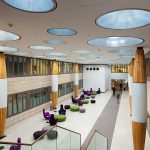Structures become dilapidated due to old age just like an ordinary human being. The reasons have to be studied properly and solutions arrived at, and only a qualified and experienced engineer can plan the work.
Rehabilitation of Older Existing Structures
The human body becomes deteriorated upon ageing. To a certain extent, the problem can be remedied by taking necessary preventive steps at the appropriate time.
This is exactly the case with buildings. As time passes, the condition of buildings also becomes deteriorated. Unless corrective methods are taken, it may so happen that the safety of the building itself may be jeopardized.
There are other factors that necessitate renovation. These are accidents, environmental factors, alteration to structures, etc. The construction associated with already-constructed structures is called renovation. Some people call the process of rehabilitation “Forensic Engineering.” The role of the engineer is just like that of a doctor trying to diagnose the disease of a patient and then recommending corrective treatment. Maintenance of constructed structures includes preventive care, repairs, and rehabilitation.
Rehabilitation of structures is a multi-disciplinary activity. The concerned engineer should know the design aspects, environmental factors, construction procedure, and about building materials. The rehabilitation of existing structures is a more complicated and sophisticated assignment than new construction.
Causes of Deterioration of Structures
A structure becomes deteriorated for the following reasons:
○ Defective Construction:
If proper supervision and inspection are not carried out during the construction, the work will be defective. Such structures may show signs of deterioration in due course of time. The ageing and atmospheric effects will increase the degree of deterioration.
○ Defective materials:
If poor quality materials are used in the construction, deterioration can occur at a fast rate. Proper inspection and quality control of the materials is a must. Where required, materials that can withstand the effects of fire should be used.
○ Environmental factors:
The main environmental factors are atmospheric pollution, floods, and earthquakes. Industries in the surrounding areas may inject poisonous gases such as sulphur dioxide into the atmosphere, which in turn may cause deterioration of the structures.
○ Design drawbacks:
If the design is not per the prescribed norms in tune with the site conditions, it may cause defects. For example in seismic zones, the additional force on account of the vibrations has to be taken into account.
Diagnosing Problems for Older Structures
Once the details of the causes are known, the same have to be analyzed to arrive at a suitable solution. For this, the structure is to be inspected and required data collected:
The data to be collected are:
○ Assumptions made in the design and verification of design calculation
○ Quality of materials used in the construction
○ Result of soil investigations, ground water analysis
○ Quality control and method of construction
Tests to be done:
The following tests are to be conducted on the samples taken from the structure and on the structural members.
○ Testing of concrete for ascertaining the compressive strength
○ Sampling and testing of subsoil
○ Chemical analysis of subsoil water
○ X ray diffraction tests on concrete
○ Hammer or ultrasonic tests on concrete
○ Load tests
○ Permeability tests
○ Vibration studies
Analysis of the problem and solution:
Based on the results of tests and field observations, it will be possible to arrive at the actual cause of the problem and suggest suitable remedial action. Various alternative methods of solutions may be looked into taking into account the safety, economy, and time required for the work. The most suitable method among the alternatives may then be selected.
Visual Indications of Distress Conditions
○ Formation of cracks in the structure in different patterns
○ Peeling of plasters
○ Spalling of concrete
○ Yielding of steel
○ Rusting of exposed steel
Rehabilitation and Renovation – The Work
Rehabilitation work involves the following steps.
○ Access arrangements:
Special gadgets may be required to get access to that part of the structure where the work is to be carried out. The access arrangements may be in the form of suspended platforms, scaffoldings, jacking arrangements, anchoring systems, etc.
○ Materials required:
In choosing the materials, the following points may be kept in mind:
Timely availability of the material, safe handling, adverse effect on the structure, surface preparation required, availability of the equipment and financial implications.
○ Sequence of operations:
The process of rehabilitation has to carried out in such a manner that the safety of the structure is not jeopardized. Therefore it is necessary to plan the operations properly and then carry out it accordingly.


Due to ageing, structures may get damaged and unless effective steps are taken to renovate, safety may be affected. As such, it is necessary to plan well in advance and take necessary preventive steps.


